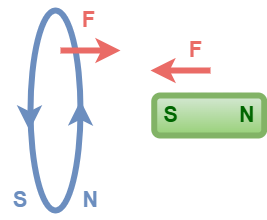Current Carrying Circular Loop-
Before you go through this article, make sure that you have gone through the previous article on Magnetic Field At Center of Current Carrying Circular Loop.
We have learnt-
- In 1820, Oersted discovered that a current carrying conductor produces a magnetic field around it.
- A current carrying circular loop produces a magnetic field around it.
- The magnetic field at the center of a current carrying circular loop is given by-

In this article, we will learn about the current carrying circular loop as a magnetic dipole.
Current Carrying Circular Loop As A Magnetic Dipole-
|
A magnetic dipole is an arrangement of two equal and opposite magnetic poles separated by some distance.
|
A current carrying circular loop behaves as a magnet / magnetic dipole.
The comparison of the magnetic field lines of the circular loop and a bar magnet shows that the two patterns are similar.


On observing the loop from one side,
- The current seems to flow in anticlockwise direction.
- Magnetic field lines emerge out the loop from this side.
- Hence, this side of the loop acts as a North pole.

On observing the loop from the other side,
- The current seems to flow in clockwise direction.
- Magnetic field lines enter the loop from this side.
- Hence, this side of the loop acts as a South pole.

Conclusion
|
Thus, we say that a current carrying circular loop behaves as a magnet / magnetic dipole.
NOTEIt may be noted that every loop whether rectangular, square, hexagonal or elliptical acts as a magnet. |
This can be verified by studying force on one current carrying loop due to a magnet or another current carrying loop.
Example-01:

Here, the loop and the magnet attract each other.
Example-02:

Here, the two loops attract each other.
MCQs Quiz-
MCQs Quiz
on Current Carrying Circular Loop As A Magnetic Dipole
Worksheet-
Worksheet
on Current Carrying Circular Loop As A Magnetic Dipole
Next Article-
Magnetic Dipole Moment of a Current Carrying Loop
Get more notes & other study material of the Chapter Moving Charges & Magnetism.


